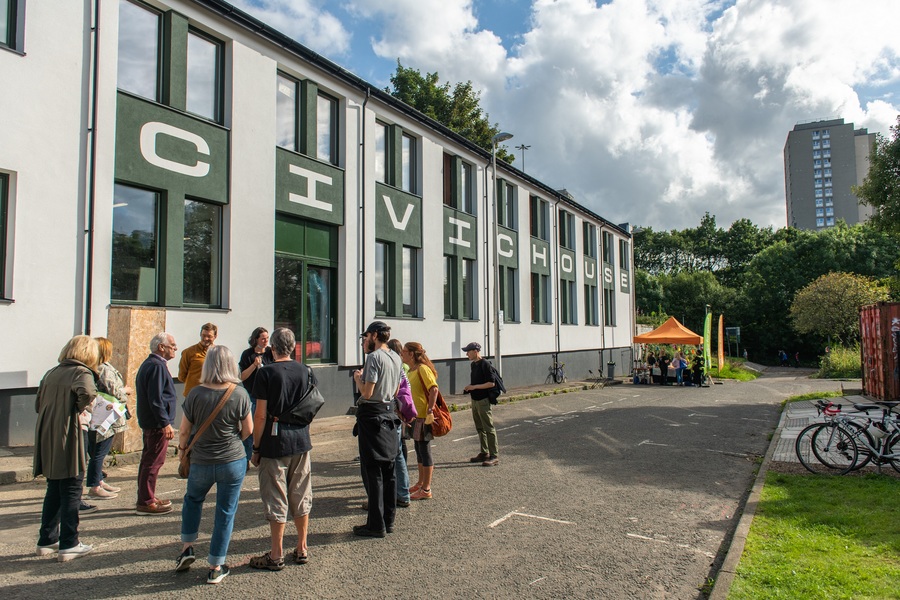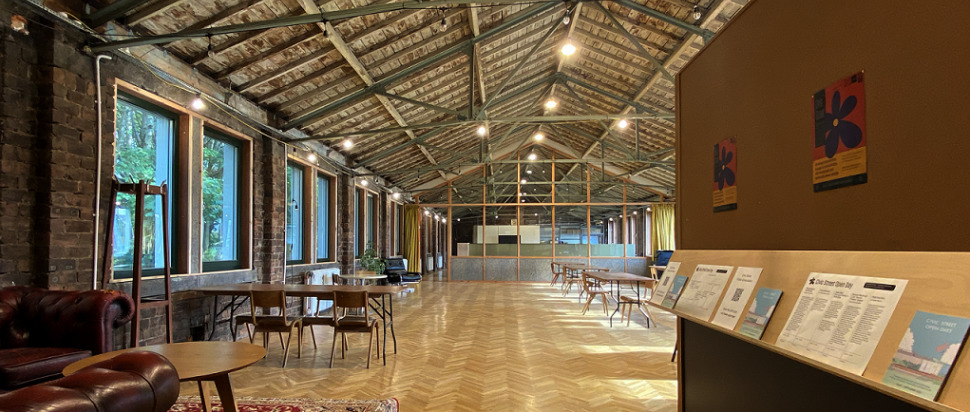Civic House: A 21st-Century Power Station
A former printing press for Glasgow’s political movements built in the 1920s, Civic House has been shortlisted for a prestigious AJ Retrofit Award after a radical transformation by Agile City in collaboration with Collective Architecture
At over 100 years old, Civic House is a pioneering example of how design can improve Scotland’s existing building stock to support a low-carbon, climate-ready future. In 2023, factories that once symbolised industrial growth can now support new green industries, and act as the micro-power stations of the future…
Now a co-working space, venue and canteen, the building is shortlisted for an AJ Retrofit Award in the category of ‘Workplace’ which recognises and celebrates the design expertise behind the renewal and repurposing of existing buildings, setting a precedent for ways to significantly cut the architecture industry’s carbon footprint. The building is now 'energy positive', meaning it has the ability to generate more energy than it consumes. Civic House provides work and event space for architecture, design, making, food, film and music. A co-working and studio space presents events and exhibits while the newly launched Parveen’s, a Pakistani-inspired canteen run by sisters Fariya and Sahar Sharif, offers a bustling lunch service four days a week and regular supper clubs in the evenings. The venue and project space can be hired out for events, workshops, conferences and festivals like the Glasgow Short Film Festival, Counterflows, Architecture Fringe as well as gigs, performances and talks.
Agile City’s director Rob Morrison explains: “With recent global political and economic events, the need for more localised energy generation and networks is an issue that needs to be tackled from the scale of the personal to that of the building and the city. Having local energy means organisations can become more resilient to global forces; it allows us to invest in our facilities to support the work of our community working across architecture, design, food, music, film and social enterprise.”
Collective Architecture were commissioned by Agile City to undertake the refurbishment and thermal upgrade of the North Glasgow building. The core principle of the project was to create a leading example that demonstrated carbon reduction innovation as Scotland’s first retrofit ‘PassivWareHaus’.

Civic House. Photo: Tiu Makkonen
Supporting the design and delivery of local climate action
“Glasgow has demolished large numbers of industrial buildings over the past 50 years. It is estimated that approximately 75% of the UK’s existing building stock will still be in use in 2050. If we want to help mitigate the effects of climate change, we need to drastically improve the efficiency of our existing buildings. Civic House is a compelling case-study for the repurposing of a post-industrial building, contributing towards an energy-efficient, low-carbon and climate-ready future, and improving our knowledge of how to upgrade the existing building stock,” says Collective Architecture’s Emily Koh.
After an extensive energy analysis and feasibility study the designers agreed on a step-by-step approach and Collective Architecture worked collaboratively with Agile City from the outset to find cost effective ways of retrofitting the building to high levels of performance. Keen to make the building an exemplar, the Civic House team were very hands-on and a key part of pushing the potential for the building to be retrofitted to the highest standards.
Using the EnerPHit model, the goal was to create a standard for an economically and ecologically optimal energy retrofit, for old buildings that cannot achieve Passive House Standard easily. In 2019 a design process was used to develop a Passivhaus Retrofit strategy. Passivhaus is a design process that uses some key principles to reduce energy demand for keeping buildings heated efficiently. It is founded on five principles: 1. high level of insulation, 2. airtightness, 3. no thermal bridges, 4. high-quality windows and doors, 5. ventilation (MVHR).
Since completion, Civic House has been able to reduce energy demand for heating by over 80%. The building is based in Speirs Locks, North Glasgow, an area that has been dramatically affected by the loss of industry and the construction of the M8 motorway in the 1960s. The Agile City team have worked in the area since 2011, developing projects that respond to this context by considering sustainable approaches to re-purposing industrial buildings and addressing issues of vacant space through activation, testing and learning. The building has been designed around a communal kitchen which is 'the heart of the house' and is open daily to build connections with people working in the building and in the local area; one of Scotland’s unique cultural districts and home to institutions and places of cultural production, from The Glasgow School of Art and the Royal Conservatoire to the Glue Factory and Glasgow Sculpture Studios.
“The outcome of this work is allowing us to invest in facilities and projects that support the regeneration of our local area. In essence, some of the factories that once supported industrial growth can now support new green industries and knowledge exchange; creating ‘micro-power-stations’ of energy and ideas for the future” says Morrison.
With changes to global industry and manufacturing there is an increasing number of post-industrial buildings that are underutilised across the UK. Change needs to be rooted in context and respond to local skills, demands and assets. Civic House is a product of this ethos and hopes to inspire organisations and communities to take on their own retrofit projects by sharing knowledge through events, talks, articles, and future research publications.
More info at agile-city.com
@civichouse_
@agilecity_
@collectivearchitecture
@parveens_canteen
@localheroesdesign
